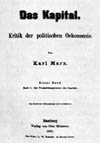
Karl Marx on the steam engine

There were mules and steam-engines before there were any labourers, whose exclusive occupation it was to make mules and steam-engines; just as men wore clothes before there were such people as tailors. The inventions of Vaucanson, Arkwright, Watt, and others, were, however, practicable, only because those inventors found, ready to hand, a considerable number of skilled mechanical workmen, placed at their disposal by the manufacturing period. Some of these workmen were independent handicraftsman of various trades, others were grouped together in manufactures, in which, as before-mentioned, division of labour was strictly carried out. As inventions increased in number, and the demand for the newly discovered machines grew larger, the machine-making industry split up, more and more, into numerous independent branches, and division of labour in these manufactures was more and more developed. Here, then, we see in Manufacture the immediate technical foundation of Modern Industry. Manufacture produced the machinery, by means of which Modern Industry abolished the handicraft and manufacturing systems in those spheres of production that it first seized upon. The factory system was therefore raised, in the natural course of things, on an inadequate foundation. When the system attained to a certain degree of development, it had to root up this ready-made foundation, which in the meantime had been elaborated on the old lines, and to build up for itself a basis that should correspond to its methods of production. Just as the individual machine retains a dwarfish character, so long as it is worked by the power of man alone, and just as no system of machinery could be properly developed before the steam-engine took the place of the earlier motive powers, animals, wind, and even water; so, too, Modern Industry was crippled in its complete development, so long as its characteristic instrument of production, the machine, owed its existence to personal strength and personal skill, and depended on the muscular development, the keenness of sight, and the cunning of hand, with which the detail workmen in manufactures, arid the manual labourers in handicrafts, wielded their dwarfish implements’ Thus, apart from the dearness of the machines made in this way, a circumstance that is ever present to the mind of the capitalist, the expansion of industries carried on by means of machinery, and the invasion by machinery of fresh branches of production, were dependent on the growth of a class of workmen, who, owing to the almost artistic nature of their employment, could increase their numbers only gradually, and not by leaps and bounds. But besides this, at a certain stage of its development, Modern Industry became technologically incompatible with the basis furnished for it by handicraft and Manufacture. The increasing size of the prime movers, of the transmitting mechanism, and of the machines proper, the greater complication, multiformity and regularity of the details of these machines, as they more and more departed from the model of those originally made by manual labour, and acquired a form, untrammelled except by the conditions under which they worked, the perfecting of the automatic system, and the use, every day more unavoidable, of a more refractory material, such as iron instead of wood-the solution of all these problems, which sprang up by the force of circumstances, everywhere met with a stumbling-block in the personal restrictions, which even the collective labourer of Manufacture could not break through, except to a limited extent. Such machines as the modern hydraulic press, the modern power-loom, and the modern carding engine, could never have been furnished by Manufacture.
A radical change in the mode of production in one sphere of industry involves a similar change in other spheres. This happens at first in such branches of industry as are connected together by beingseparate phases of a process, and yet are isolated by the social division of labour, in such a way, that each of them produces an independent commodity.